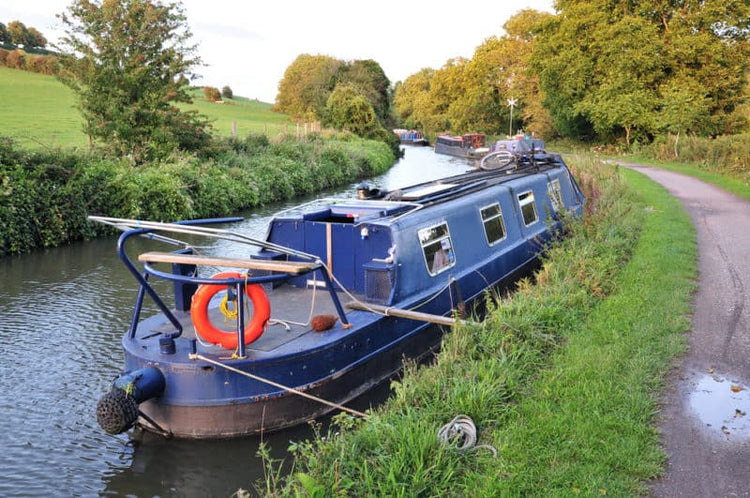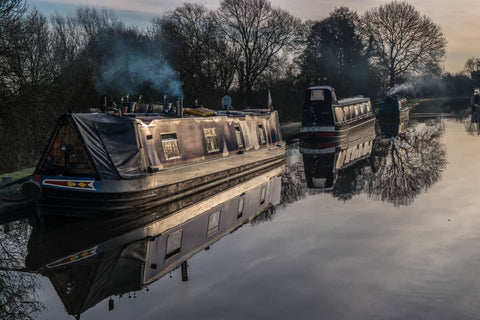Common Dangers and Practical Narrowboat Safety Tips for Canal Boaters

I've had so many great times messing about in my canal boat, but really... how often do we stop and consider the dangers?
Okay, I admit canal travel is in no way comparable to the dangers of bluewater ocean sailing, but some rules still need to be respected.
If I told you that nearly 200 people meet their deaths falling into the canals every year, it puts danger into perspective.
So how do we avoid becoming a terrible statistic? It's time to think about the risks.
Off the Narrowboat

Unlike sailboats, canal boating involves an extraordinary amount of getting on and off the vessel - when you come to a lock, when you're in a lock, swing bridges and on and on - the number of times you step off the boat are numerous. So, what do we need to think about?
Best Practice for Working Locks
First and foremost, make sure you wear sensible shoes.
Working locks are the one place on the canal network where you encounter violent and deep water. Not to mention that maneuvering around the lock on foot is a challenge in itself.
At some point, you'll face the peril of climbing across a narrow lock gate with nothing but a thin handrail to cling to (and try doing it in wet weather).
So what should you do to minimize the risks?
- Make sure there are no trailing ropes to trip you up.
- If you have long hair, make sure it's free of the lock mechanisms.
- Never rush. Take your actions slowly and methodically, especially when boating solo.
- Keep your cell phone handy in case of emergencies (but not directly in use while stepping on and off).
- Don't be afraid to ask for help. Boaters are a friendly bunch and eager to lend a hand.
- Make sure the lines used to steady the boat in the locks have enough slack as the water empties from the chamber.
Best Practice for Swing Bridges
When approaching a swing bridge, make sure you disembark onto the bridge landing when the boat is stationary. Never try and breach the gap by overstretching your leap.- Always open the bridge entirely, allowing clear passage for the boat.
- Keep people from standing on the bridge while it's being operated.
- Avoid being too vigorous when opening the bridge. It may spring back against the barrier and cause injury or damage.
- If the bridge is too stiff, locate some help.
- Always screw in the locking bolt after use and when the bridge is closed.
Best Practice for Lift Bridges
The same rule applies here as the swing bridge. Disembark carefully to avoid slipping or injury.
It's worth remembering that canal boats weigh up to 35 tons. You'll feel it when you get your leg trapped between the vessel and bridge landing.
- Never lift the bridge if it's too stiff. It's best to get help.
- Always raise the bridge fully. This keeps the skipper from banging his head and falling in.
- Make sure nothing is hanging down that could get snagged. Some lift bridges have chains so they can be pulled shut as the boat goes through.
- Never close the bridge too early while the boat is underneath.
- Never let anyone play on the bridge while operating it.
Best Practice When Mooring by the Towpath
Canal towpaths are busy places, full of people out for a nice walk or ride. So, when you approach the canalside and attempt to moor up, there are some basic rules to observe:- Only throw ropes when someone's there to catch them or there's no one about to cause injury.
- The same goes for mooring pins, gangplanks and other tools needed to moor by the bankside.
- Avoid placing your ropes across the walkway as this causes a trip hazard.
- Always place your mooring pins nearest the canal and away from walkers and cyclists. Never put the mooring pins into the middle of the towpath.
- Use something bright or reflective to show where the mooring pins are, especially at night.
One final tip: When you choose a spot to moor, try not to do it on a bend or near a narrow spot. The last thing you want is for another boat to run into you.
When you speak to canal boaters, they all say it's a contact sport. Well, it doesn't need to be if you use common sense and reduce the risks.
On the Narrowboat

When you're on the boat, there are additional safety precautions you should consider:
Basic Tools and Life-Saving Safety Equipment
Keep a supply of handy tools on the boat for emergencies. Sounds obvious, doesn't it? But you'd be amazed how many people are ill-prepared when setting off on a trip.
It doesn't have to be comprehensive; just the basics will do. A screwdriver, a hammer, a saw, a set of spanners (check price on Amazon) ... you get the picture.
Also, try to get into the habit of carrying spare alternator belts, fuel filters and oil.
As far as potentially life-saving boat safety equipment, here are some essential tools you should have on your narrowboat:
- Fire Extinguisher (check price on Amazon) - Make sure you have them checked and tested once a year. And learn how to use them.
- Smoke Detector (check price on Amazon) - Fires aren't frequent, but they are a real hazard. Check the batteries once a week.
- Carbon Monoxide Detector (check price on Amazon) - Position them at sleeping height and check the batteries once a week.
- Fire Blanket (check price on Amazon) - Great for putting out smaller fires instantly. Keep them near the galley.
- Air Horn - Use for emergencies and to alert other boats to your whereabouts. It can be heard up to a 1/2 mile away.
Fire Risks of Narrowboat Stoves
Narrowboat stoves are excellent sources of heat, but with their advantage comes considerations. The stove needs some maintenance to function efficiently and to prevent fires.- When lighting fires, always ensure proper ventilation in case smoke or fumes escape. It's also possible for loose logs and coal to fall out, so make sure you stack them at the back of the fire. Once the fire ignites, shut the stove door.
- Make a clear space around the stove and avoid stacking spare wood logs near the fire.
- Sweep the stove once a year, usually just before winter. You can do it yourself with a small wire chimney brush (check price on Amazon). Ensure the heat bricks in the burner are fit for purpose and haven't crumbled away.
- Should the worst happen and you have a fire, make sure everyone on board knows the drill.
Boat Safety Scheme
Most boats on the UK's canal network are required to have a valid safety certificate. You don't need one if the boat's an "Open boat" like a canoe or rowboat, and is privately owned.
It's especially important to acquire a certificate if your boat has gas canisters on board.
Required every four years, the safety inspection is in-depth and looks at your boat's safety equipment, electrical system, batteries, gas supply and diesel supply.
It shouldn't be confused with a service or any other inspection, but the recommendations should be acted upon, especially if you want to obtain a valid license to travel on the canals and rivers.
Good Habits for Narrowboat Safety
To make life easier, here are some good straightforward habits:- Coil ropes neatly out of the way when they aren't in use. That way no one is going to trip up and fall in.
- Conduct a pre-check before you set off. Check the boat's oil levels and water coolant levels, searching for any leaks. Generally, it's worth sticking your head into the engine bay and having a good look.
- Keep a watch on the weather through an app on your phone. That way, you'll never get caught short should the heavens open and dump some wet stuff on you.
- Make sure pets are secured in the boat. And never let children run along the roof of the vessel. I've seen that done in a lock! I had to say something to the parents because the risks were significant.
- Wear sensible boating shoes as previously mentioned. They don't have to be steel-toe workers' boots, a pair of Converse will do. Just make sure they aren't going to slip off and that they have a decent tread.
- Avoid wearing flip-flops, especially when operating a lock. I probably don't need to explain why it's a bad idea, but I've seen it first-hand on my travels.
Featured Boat Care Product
 |
Deck Cleaner resists build-ups and returns decks to a sparkling white shine. |
Check Price on Amazon - Better Boat's deck cleaner breaks down dirt and grime on painted and fiberglass decks. It leaves a polymer non-slip finish. Use a stiff scrub brush to eliminate stubborn stains.
Conclusion
Keeping yourself safe comes down to two things: Common sense and personal responsibility. If it looks and feels wrong, it probably is, so you shouldn't do it.
Taking responsibility for your actions will prevent putting yourself, and possibly others, in danger. Boating is so much fun, but it's only fun because of the safe choices we make.

